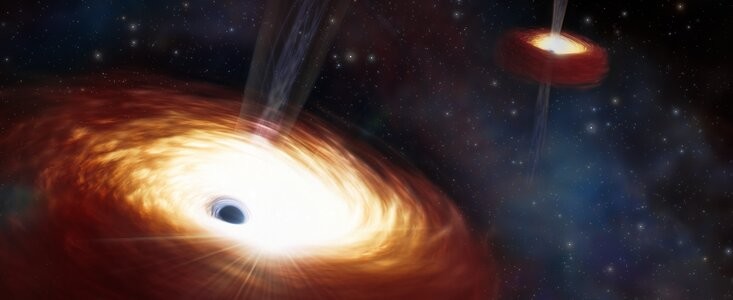Fraser Cain on Nostr: Astronomers have found supermassive black holes at the hearts of most galaxies, but ...
Astronomers have found supermassive black holes at the hearts of most galaxies, but how did they form? It was assumed that black holes merged time and time again into larger and larger objects. Now astronomers have found a pair of supermassive black holes orbiting one another at just 24 light-years, the closest ever seen. The two measure 28 billion solar masses, the heaviest ever seen. Will they eventually merge or stall out within a few light years?
https://noirlab.edu/public/news/noirlab2405/ 
Published at
2024-03-02 00:46:03Event JSON
{
"id": "74f733ab3d9569abd6f3069d79e1dffa944eaa27553d57bf6d0a1124434765d4",
"pubkey": "ac844e7de79ee4ba0cc0999efe9afb25cc9bd99ba0b5957cf0fd406fcabaf11a",
"created_at": 1709340363,
"kind": 1,
"tags": [
[
"proxy",
"https://m.universetoday.com/users/fraser/statuses/112023330044390215",
"activitypub"
]
],
"content": "Astronomers have found supermassive black holes at the hearts of most galaxies, but how did they form? It was assumed that black holes merged time and time again into larger and larger objects. Now astronomers have found a pair of supermassive black holes orbiting one another at just 24 light-years, the closest ever seen. The two measure 28 billion solar masses, the heaviest ever seen. Will they eventually merge or stall out within a few light years?\n\nhttps://noirlab.edu/public/news/noirlab2405/\n\nhttps://m.universetoday.com/system/media_attachments/files/112/023/330/038/221/950/original/837d9ab4ff600a66.jpg",
"sig": "89a5d4dc7e3f5f80f1a3dfa7cbc482b9e00bb95529355e25a7c2e2bec22ff888c0f8ca74112ad515e4c5a20525380b2649f185b0313c68e70a3a1373d2c95c1d"
}

